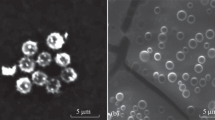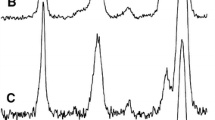Abstract
The surface characteristics of bovine and egg albumin microspheres were examined using four anionic dyes; sodium fluorescein, eosin, erythrosin, rose bengal, and the cationic dye rhodamine B. The adsorption isotherms of the dyes on unloaded albumin microspheres exhibited Langmuir behavior for dilute solutions of rose bengal, erythrosin, and eosin, suggesting monolayer formation in the initial stages of the sorption process. The adsorption capacity of the microspheres for the dyes (k 2) and the affinity constants of the dyes for the microspheres (k 1) were found to depend on both the polarizability and the hydrophobic properties of the dye, presumably reflecting the heterogeneous character of the microsphere surface. Further, the extent of sorption at higher dye concentrations was found to depend on the ability of the dye to form stable aggregates inside the microspheres and on environmental long-range forces acting at these sites. At both low and high dye concentrations, the amount adsorbed to the microsphere surface increased with increasing hy-drophobicity of the dyes. The lowest adsorption was observed for the nonsubstituted dye fluorescein, whereas the most hydrophobic dye used, rose bengal, was completely adsorbed onto the microsphere surface. The data suggest that the bovine albumin microsphere surfaces are highly hydrophobic and less porous than egg albumin microsphere surfaces.
Similar content being viewed by others
REFERENCES
A. Trouet, D. D. Campeneere, M. D. S. Maleugreaux, and G. Atassi. Experimental leukemia chemotherapy with a “lysosomotropic” adriamycin DNA complex. Eur. J. Cancer 10:405–411 (1974).
G. Cornu, J. L. Michaux, G. Sokal, and A. Trouet. Daunorubicin-DNA: Further clinical trails in acute non-lymphoblastic leukemia. Eur. J. Cancer 10:695–700 (1974).
K. Egbaria, C. Ramachandran, D. Kittayanoad, and N. Weiner. Topical delivery of liposomally encapsulated interferon evaluated by in vitro diffusion studies. Antimicrob. Chemother. Agents 34:107–110 (1990).
R. R. Martodam, D. Y. Twumasi, I. E. Liener, J. C. Powers, N. Nishino, and G. Krejcarek. Albumin microspheres as carrier of an inhibitor of leukocyte elastase: Potential therapeutic agent for emphysema. Proc. Natl. Acad. Sci. USA 76(5):2128–2132 (1979).
K. J. Widder, G. Flouret, and A. Senyei. Magnetic microspheres synthesis of a novel parenteral drug carrier. J. Pharm. Sci. 68:81–94 (1979).
K. Egbaria and M. Friedman. Sustained release albumin microspheres containing antibacterial drugs: Effects of preparation conditions on kinetics of drug release. J. Control. Release 14:79–94 (1990).
K. Sugibayashi, Y. Morimoto, T. Nadai, Y. Kato, A. Hasegawa, and T. Arita. Preparation and tissue distribution in mice of microsphere-entrapped 5-fluorouracil. Chem. Pharm. Bull. 27:204–209 (1976).
E. Tomlinson, J. J. Burger, J. G. Mcvie, and K. Hoetuagel. In J. M. Anderson, and S. W. Kim (eds.), Recent Advances in Drug Delivery Systems, Plenum Press, New York, 1983.
U. Scheffel, B. A. Rhodes, T. Natarajan, and H. N. Wagner. Albumin microspheres for study of the reticuloendothelial system. J. Nucl. Med. 13:498–503 (1972).
E. Tomlinson. Microsphere delivery systems for drug targeting and controlled release. Int. J. Pharm. Tech. Mfr. 4(3):49–57 (1983).
L. Arbeloa. Dimeric and trimeric states of the fluorescein dianion. J. Chem. Soc. Faraday Trans. 2:77:1725–1733 (1981).
K. K. Rohatgi and A. K. Mukhopadhyay. Aggregation properties of anions of fluorescein and halofluorescein dyes. J. Indian Chem. Soc. 49(12):1311–1320 (1972).
A. Suggett. The physics and physical chemistry of water. In F. Franks (eds.), Water—A Comprehensive Treatise, Plenum Press, New York-London, 1972, Vol. 1, Chap. 14.
A. N. Glazer. Proc. Natl. Acad. Sci. USA 65:1057 (1970).
K. Egbaria and M. Friedman. Physico-chemical properties of albumin microspheres using spectroscopic studies. J. Pharm. Sci. 81:186–190 (1992).
K. K. Rohatgi and A. K. Mukhopadhyay. Thermodynamics of dye dimerization. Chem. Phys. Lett. 12(2):259–260 (1971).
K. K. Rohatgi and G. S. Singhal. Nature of bonding in dye aggregates. J. Phys. Chem. 70:1695–1701 (1965).
L. Arbeloa and P. Ruiz Ojeda. Chem. Phys. Lett. 87:556–560 (1974).
A. Leo, C. Hansch, and D. Elkins. Partition coefficients and their uses. Chem. Rev. 71(6):525–616 (1971).
Author information
Authors and Affiliations
Rights and permissions
About this article
Cite this article
Egbaria, K., Friedman, M. Adsorption of Fluorescein Dyes on Albumin Microspheres. Pharm Res 9, 629–635 (1992). https://doi.org/10.1023/A:1015897909739
Issue Date:
DOI: https://doi.org/10.1023/A:1015897909739




